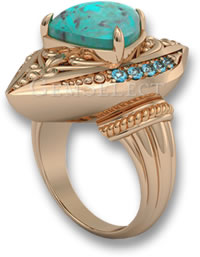Semi Precious Turquoise
Ancient History of Turquoise
Turquoise has a rich history that spans centuries and continents. Ancient civilizations, like the Sumerians and Egyptians, cherished this vibrant blue stone. In Egypt, turquoise was mined in the Sinai Peninsula, known as "Mafkat" or "the land of the green minerals." This region earned its nickname, "the land of turquoise," due to its abundant deposits. One iconic example is King Tutankhamen's burial mask, adorned with turquoise inlay, showcasing its significance in ancient Egyptian culture. The stone's vivid blue was thought to symbolize regeneration, making it a prized material for both adornment and ritual. For more details on this gem’s historical significance, explore our comprehensive turquoise guide.

Persian Turquoise and Trade
In Persia (modern-day Iran), turquoise holds a special place as the national gemstone. Mined for thousands of years, Persian turquoise traveled along ancient trade routes like the Silk Road, reaching Europe and beyond. Early writers, including Shakespeare in The Merchant of Venice, referenced its beauty, with a turquoise ring symbolizing deep sentimental value. The term "turquoise" itself derives from the French for "Turkish stone," as Turkish traders introduced it to Europe. Persian turquoise is renowned for its sky-blue hue, often called "robin's egg blue," and its smooth, matrix-free texture. While blue is the classic shade, some folks also love the stone’s yellowish-green or lime-green variations. Pretty versatile, right? Learn more about this gem’s unique qualities in our detailed turquoise overview.
Chinese and Tibetan Turquoise
China, especially Hubei Province, is another major source of turquoise. Historically, the Chinese imported gemstones but now supply much of the world’s turquoise. They’ve used it for intricate carvings and inlay, though jade often took center stage in their jewelry. In Tibet, turquoise is more than just a pretty stone - it’s considered protective, tied to good fortune and health in spiritual beliefs. Its color mirrors sacred lakes and clear skies, making it a staple in traditional Tibetan and Nepalese jewelry. If you’ve ever seen a Tibetan piece, you know how striking that blue pop can be! Discover the unique appeal of green turquoise varieties used in these cultural designs.

Turquoise in the Americas
In the Americas, turquoise was a cornerstone of Aztec artistry, used in stunning mosaic masks and a double-headed serpent. The Aztec emperor Montezuma II reportedly gifted turquoise to Hernando Cortés, valuing it above gold and silver. In North America, mines in Nevada, Arizona, New Mexico, and Colorado - like the Montezumo Turquoise Mine - have been key sources. Native American tribes, particularly the Navajo, mastered turquoise beadwork and mosaics, later incorporating it into silver jewelry around 1880. The stone’s influence even inspired "Tiffany Blue," the signature color of Tiffany & Company, who used turquoise in jewelry as early as the 1860s. Talk about a gem that’s left its mark!
Turquoise in European Jewelry
Turquoise reached Europe through Persian trade and Spanish conquistadors returning from the Americas. By the 19th century, it became a favorite in "forget-me-not" jewelry, symbolizing love and remembrance due to its resemblance to the flower’s blue hue. It shone in Art Nouveau and Art Deco designs, often paired with diamonds and onyx. Later, the Hippie Movement embraced turquoise in tribal-style pieces, though this led some to view it as less "fine" compared to high-end designs by jewelers like Van Cleef & Arpels or Bulgari. Elizabeth Taylor’s 1965 Bulgari necklace, featuring turquoise alongside emerald and amethyst, proves its timeless appeal.

Modern Popularity and Versatility
Today, turquoise is enjoying a renaissance, gracing red carpets and trade shows like Baselworld. While it’s scarcer in places like the American Southwest, its unique beauty keeps it in demand. Despite being labeled "semi-precious" due to its softness or opacity, turquoise shines in both casual tribal silver pieces and high-end platinum designs. Its vibrant blue pairs beautifully with black, white, neutrals, or even gold. Like the Mediterranean Sea, turquoise’s charm is timeless, ensuring it’ll never go out of style. Who wouldn’t want a piece of that history on their finger or neck?
Frequently Asked Questions
What is turquoise?
Turquoise is a semi-precious gemstone, typically blue or greenish-blue, composed of hydrated phosphate of copper and aluminum. It’s valued for its vibrant color and cultural significance.
Where is turquoise found?
Turquoise is mined in regions like Iran, China’s Hubei Province, Egypt’s Sinai Peninsula, and the American Southwest (Nevada, Arizona, New Mexico, and Colorado).
How can I tell if turquoise is real?
Authentic turquoise can be identified through gemological testing, such as checking its hardness (5-6 on the Mohs scale) or using magnification to inspect its matrix and texture.
Why is Persian turquoise special?
Persian turquoise is prized for its smooth texture, lack of matrix, and vibrant "robin's egg blue" color, considered the finest quality by many gem enthusiasts.
Disclaimer: Claims about turquoise's healing or spiritual properties, such as protection or good fortune, are based on cultural beliefs and traditions. There is no scientific evidence to support these claims. Always consult a professional for medical or health-related advice.

